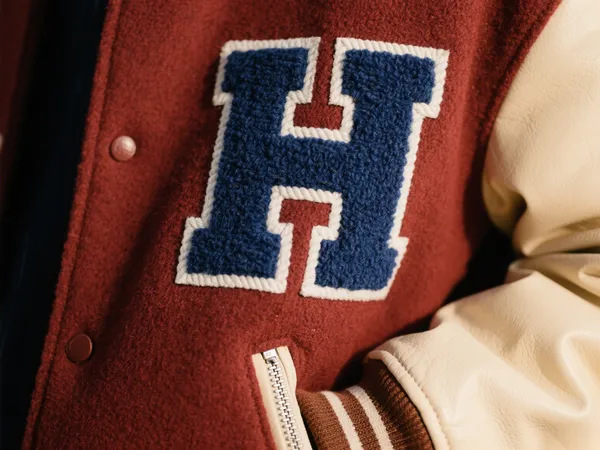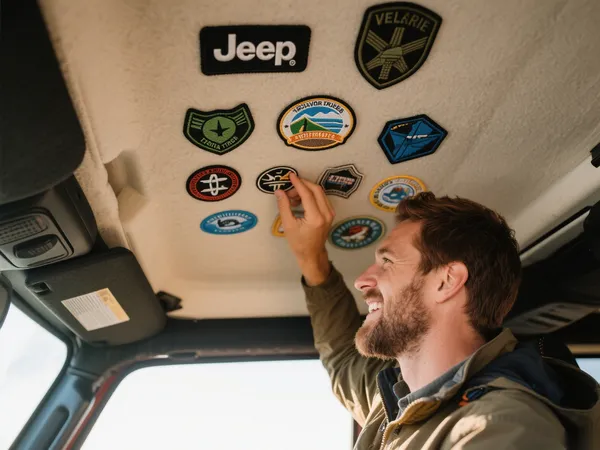Dans le monde de la mode personnelle et de l’expression culturelle, peu de vêtements ont le même statut iconique que le gilet patchQu'ils soient portés par des motards, des punk rockers, des vétérans militaires ou des passionnés de mode DIY, les gilets patchés ont longtemps servi de toiles portables : chaque patch racontant une histoire, partageant un message ou affichant fièrement une affiliation.
Mais les gilets à patchs sont bien plus que de simples pièces de mode. Ils représentent l'identité, les valeurs et la communauté. Dans ce blog, nous explorons ce qui rend les gilets à patchs si spéciaux, comment créer le vôtre et pourquoi choisir le bon. patchs de gilet de motard personnalisés ou coudre des patchs est essentiel pour construire quelque chose de vraiment significatif.

Qu'est-ce qu'un gilet patch ?
Un gilet à patchs est généralement un gilet sans manches en jean, en cuir ou en toile, orné d'une série d'écussons brodés, tissés ou en PVC. Ces écussons peuvent inclure des logos de club, des insignes de grade, des slogans, des drapeaux, des souvenirs d'événements ou même des références à la culture pop. Au fil du temps, un gilet à patchs bien usé devient un témoignage unique de ses affiliations, de ses réalisations et de ses voyages.
Les gilets patchés sont particulièrement populaires dans les communautés suivantes :
- Clubs de moto et groupes de motards
- Organisations militaires ou d'anciens combattants
- Fans de musique punk et métal
- Les cercles du streetwear et de la mode
- Passionnés de cosplay et de fandom
Chaque patch représente une couche de l'histoire du porteur, et le gilet les rassemble tous.
Types de patchs pour gilets
Avant de construire votre gilet patch, il est important de comprendre les différents types de patchs disponibles :
- Embroidered Patches
Ce sont les plus traditionnels et les plus populaires. Ils offrent un look cousu classique et s'accordent parfaitement avec le denim ou le cuir. - Patchs tissés
Idéal pour les motifs très détaillés. Ces modèles utilisent des fils plus fins et des coutures plus serrées, permettant des motifs complexes et des petits textes. - Patchs en PVC ou en caoutchouc
Idéals pour des designs modernes et durables. Les patchs en PVC sont résistants à l'eau et parfaits pour une utilisation en extérieur ou tactique. - Patchs thermocollants ou à coudre
Les patchs thermocollants sont pratiques, notamment pour les gilets temporaires ou tendance. Cependant, coudre des patchs sont le meilleur choix en termes de longévité et de durabilité, en particulier pour les vêtements à usage intensif.

Concevoir votre propre gilet patch personnalisé
Lorsque vous commencez à créer votre gilet à patchs, il est utile de planifier la disposition et le thème. Posez-vous les questions suivantes :
- Est-ce que je veux un « patch arrière » centré avec des patchs plus petits autour ?
- Est-ce que je suis une palette de couleurs ou est-ce que je la laisse évoluer de manière organique ?
- Les patchs sont-ils personnels, humoristiques ou strictement symboliques ?
Conseils pour concevoir un superbe gilet à patchs :
- Commencez avec un gilet de haute qualité en denim épais, en toile ou en cuir.
- Choisissez un patch arrière large et percutant pour ancrer votre mise en page.
- Ajoutez des patchs thématiques sur la poitrine avant (étiquettes nominatives, drapeaux, etc.).
- Superposez des pièces plus petites au fil du temps : laissez votre gilet grandir avec vos expériences.
Et ne vous précipitez pas. Un véritable authentique gilet patch se construit au fil du temps, pas en une seule fois.
Comment appliquer des patchs sur votre gilet
Selon votre type de patch, vous disposez de quelques options d'application :
- Coudre à la main ou à la machine
La méthode la plus sûre et la plus professionnelle. Elle est recommandée pour les gilets en cuir ou en toile, notamment pour patchs de gilet de motard personnalisés. - Méthode de repassage
Convient aux tissus légers et à la décoration. Attention : sur le cuir ou les tissus imperméables, cette méthode n'est pas toujours efficace. - Support velcro ou épingles de sûreté
Utile pour un placement temporaire ou lorsque vous souhaitez avoir la possibilité d'échanger des patchs.
Conseil de pro : Si vous n'avez pas confiance en vos compétences en couture, de nombreux tailleurs ou ateliers de retouches peuvent fixer vos patchs de manière professionnelle.

Placement et étiquette des patchs
Dans certaines communautés, notamment les clubs de motards, l'emplacement des écussons revêt une signification symbolique. Par exemple :
- Le culbuteur supérieur peut afficher le nom du club.
- Le patch central montre le logo du club.
- Le bascule inférieure indique souvent l'emplacement géographique.
Porter de tels gilets sans autorisation ou sans connaissance de leur signification peut entraîner des malentendus. Soyez toujours respectueux des traditions liées aux patchs, en particulier dans les sous-cultures aux règles bien définies.
Les gilets à patchs dans la mode et la culture pop
Au cours des dernières années, gilets à patchs ont connu un regain d'intérêt dans la mode grand public. Les créateurs intègrent désormais des patchs vintage à leurs vestes et gilets en jean, tandis que les festivals de musique présentent souvent des gilets personnalisés comme moyen d'expression personnelle des participants.
Même dans les communautés de cosplay et de jeu, les gilets patchs sont utilisés pour afficher des factions fictives, des réalisations ou des icônes de jeu, ajoutant une dimension physique aux identités numériques.

Réflexions finales
Un gilet à patchs est plus qu'un simple vêtement. C'est un symbole d'individualité, d'appartenance et de créativité. Que vous fassiez partie d'un club de motards soudé, que vous soyez un adepte de mode alternative ou que vous aimiez simplement raconter des histoires à travers des patchs, créer votre propre gilet peut être une expérience incroyablement enrichissante.
Prenez votre temps pour choisir les bons matériaux, créer des patchs originaux et les coudre. Bientôt, votre gilet ne sera plus une simple tenue, mais un héritage que vous porterez sur votre dos.
Prêt à commencer à créer le vôtre gilet patch Un chef-d'œuvre ? Il vous suffit d'inspiration et de quelques patchs pour commencer.



